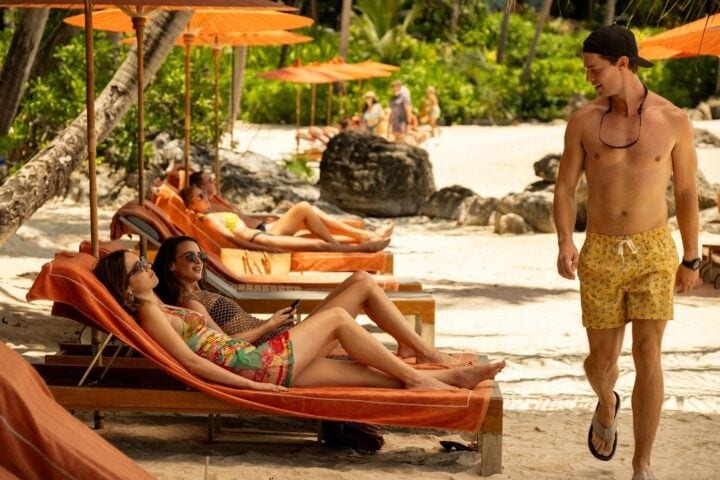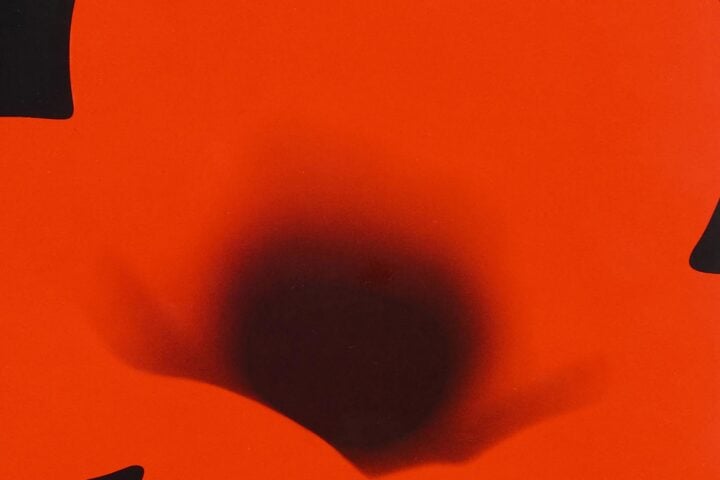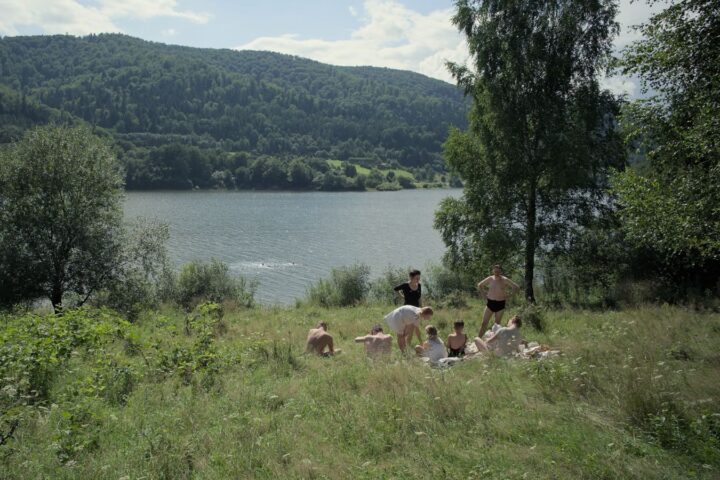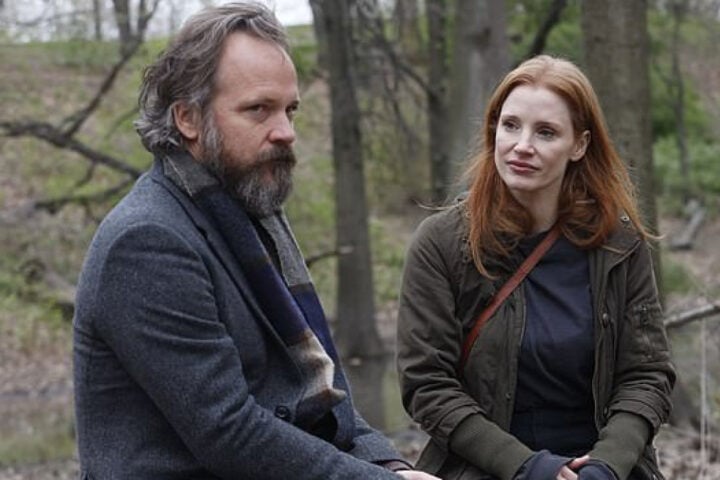For many German performers, the decision about whether or not to play a Nazi proves a fraught one. To depict the history isn’t to endorse it, of course, but to delve into how humans can fall in line behind such barbarism opens the door to finding justifications for that behavior. After playing a Jewish refugee and an attempted assassin of Hitler, actor Christian Friedel now examines this dark period in his country’s history from the other side as Auschwitz commandant Rudolph Höss in The Zone of Interest.
Writer-director Jonathan Glazer, though, dispenses with traditional lines of inquiry to understand and contextualize Höss’s atrocities. The Zone of Interest finds an all-encompassing aesthetic language to show not how Nazis rationalized their genocidal actions, but how they compartmentalized them. It’s an experience better to viscerally feel than to have intellectualized in description, but Friedel’s startlingly naturalistic portrayal of a concentration camp overseer and family man is the central cog in Glazer’s machine. Friedel surrenders himself to the filmmaker’s vision, stripping away actorly flourishes to radically reconstruct a historical figure through absences and oversights rather than standard character psychologizing.
I spoke with Friedel prior to The Zone of Interest’s American release. Our conversation covered why the lessons he learned working with Michael Haneke on The White Ribbon carried over into working with Glazer, how Zone of Interest’s unconventional shooting style informed his performance, and what he makes of the film’s surprising ending.
You had to submit a “selfie” audition tape to Jonathan Glazer and describe why you became an actor. I don’t think you’ve said it elsewhere, so why did you?
Wow, you are the first [person to ask] me that! I said it in German, but I’ll try it now in English. I was always an actor and a musician at the same time. When I was younger, as a child, it was in me. I wanted to express myself and entertain people. It started in kindergarten when I played hand puppets for other kids. It went on in the school. I was singing, acting for my schoolmates. Then my mother said, “You have to go to the theater,” and I was an extra in the theater. Now I’m 44, and I’m doing all the things like it never changed. I described it very personally in German to Jonathan, because this is a natural thing inside of me. I don’t know why, but it’s inside of me.
Your first movie was The White Ribbon with Michael Haneke, who’s known for a very exacting filmmaking style. What was that experience like?
Haneke, for me, is a mentor. [From] the casting process, I never thought I would be a part of his movie because there were some more famous names in the round. It was my first movie, but then he decided that I’d play the schoolteacher. I learned a lot in the casting process because he said to me one important [thing]: “If you go into a conversation, don’t forget the reason you started the conversation.” Maybe then you’ll talk about different things, but in the end, there’s a reason why you were talking to the person. For me, there were no questions about the script. Before shooting, he asked me, “Do you have a question?” And I was thinking, “Oh, maybe I don’t know, I have to tell him a question!” And then he said, “No, don’t ask me because there are some actors who ask many questions.” And I said, “No, it’s your decision. It’s not mine.” And that was really interesting because sometimes you watch Haneke’s movie and you have the feeling that it’s so precise. But he trusts you a lot. He gives you precise arrangements when blocking scenes, but he never said, “Please feel in this way or do it in this way. It’s your decision.” This was really interesting, with a very tight script, to have the freedom for your impulses.
That echoes what I’ve heard from other actors who’ve worked with Haneke: His rigid approach provides a kind of freedom for actors. Is that experience something you were able to pull from in making The Zone of Interest, even if it’s a bit reverse with how much latitude Jonathan Glazer gave you within a scene?
Absolutely. But Jonathan was very transparent from the beginning: He was searching. He had a phenomenal script, but he was searching [to see if] there’s something else. He invited us to figure it out together. [Unlike] Haneke, he was collecting the material and not knowing [how it] will be the cut, then using this for another scene, and so on. He was only collecting and then he decided in the post-production what he was using or not. There are a lot of scenes that he’s not using in the final cut, but Haneke only cut out one-and-a-half scenes from the original script of The White Ribbon. All the other scenes from the script were in the movie. That was really interesting because Haneke, maybe, is an inspiration for Jonathan too.
There are some connections [between the movies]. In The White Ribbon, there’s a scene where you watch only a closed door and hear what’s going on behind. Sometimes here you watch the family and hear a lot of things going on behind the wall. The children of The White Ribbon could be the future perpetrators of The Zone of Interest. We talked a lot about that. Jonathan said he read an interview from a journalist who interviewed Rudolf Höss at the Nuremberg trial, and he described Höss as sometimes a normal school teacher. So I think maybe Jonathan was thinking about the school teacher in The White Ribbon. I have to ask him! [laughs] No…
What were the challenges of playing someone described not only as a “school teacher” but also a “flower-picking” one? Do you have to do more to make someone so recessive into a watchable character?
Our shoot was like a search, and I was searching for the character too. My preparation was not traditional. I read some excerpts of his biography, but there were not so many psychological things. It was more contradictions of what’s in his mind, what it tells the body, what’s his body language, and what’s in his soul. We had a lot of conversations about that, and sometimes I was at the set and didn’t know how I could do this. It was more, “Let’s figure it out.” We had, with this multi-camera system and all the time in the world to figure out how the situation works. Then, all the scenes and decisions Jonathan made in post-production created this character.
For me, some of the most important scenes for Jonathan for this character were when Rudolph locked the house like a daily routine. It’s what’s inside his mind, the compartmentalization to ignore all the atrocities surrounding him. He locked up why he’s afraid so much. That was really interesting. But doing a scene was only like a technical thing, sometimes without knowing or thinking. To say goodbye to the horse was a different thing. I had to connect with my motional archive to create the scene. But it was more our interpretation or vision of this [real-life] person’s and not doing or creating a biopic or something.
Given the way that compartmentalization informs his character, did you feel like you couldn’t understand him until you saw the finished film with all the sounds that functions like a second movie on top of what you filmed?
Jonathan said that there will be this second movie. Movie one is the movie you watch, and movie two is the one you hear. We knew that from the beginning, but we never heard any of these sounds. I had these familiar sounds and pictures in my mind, and that was really important sometimes. It was tough to have that in your mind. Jonathan said to me, “Have it in your mind. Have this tension in your whole body, but don’t share it with me or the audience. Your eyes need to be cold.” We cannot read him because—this is important—we never see him as a perpetrator. But he is the perpetrator. He’s the commandant who built an efficient system to kill all the people. He’s thinking about his work because he said in the Nuremberg trials that he wanted to be the best in his work. That was the challenge for me: to have it in my mind, to hear the sounds, to know that they exist, but not to share it in the particular scenes we shot.
Many scenes didn’t end in a traditional sense with the director calling cut. Did not knowing when a scene was truly “over” increase the discomfort? That you couldn’t separate yourself from Höss so easily and had to continue on as him, even beyond whenever it was comfortable to do so?
This experience was really interesting because the system allowed us to stay in the tension and have all the time in the world. Sometimes Jonathan surprised us when no one said “cut” because then we had the freedom to decide: let’s continue, let’s improvise, let’s repeat it, let’s do a variation. It was really intense, in a way, but we trusted him all the time. That was really helpful in a way. But after the shooting, I was thinking a lot about this method because you are sometimes, as a human being, confronted with your fears. Sometimes, [with] nightmares. There was a scene with the kids in the canoe, and I was afraid to lose them. And I had the nightmare, “Oh, my God, what happens if I lose them in the rain in the river?” I had father feelings. That was really interesting and intense. Knowing it could happen that Jonathan might not say “cut,” [and that] it was important to be spontaneous and fearless.
You’ve rejected the idea that the Auschwitz Museum footage is Höss somehow seeing the future. Is that scene more for the viewers than the characters, then? To make concrete for us the compartmentalization Höss participating in all along?
Absolutely. Michael Haneke said films are a springboard, but the viewer has to jump. For me, the ending, what he’s thinking, what he’s seeing, the viewers have to think about it and react to what they are seeing. When it cuts back to Rudolph, it goes on and on. History repeats. I think there are a lot of questions, and it’s great to have these questions as a viewer of this movie, and then to act and think about it. I really like that it’s not an entertaining movie. It’s more of a meditation. The end, what’s going on? Does he know? I think the body knows the truth. And this is the reason that the body reacts in this way. I don’t think that he recognizes that he’s guilty because a Nazi never apologized for that. Rudolph Höss only said, “It was my work. I had to do my work, and I wanted to be the best of my work.” He [never] said sorry or, “My God, what’s going on? I was blind.” That never happened. But we have the choice to say no or be aware there’s a darkness inside of all of us. That’s our choice, and I think this is important to know.
Since you’ve had longer to live with the realization that any human is capable of perpetrating violence, what do we do with that knowledge?
Sometimes the political system changes and [people think] “I want to protect my family” or “I want to survive” or make compromises. The discussion in Germany about the Israeli-Palestinian conflict is so complex. It’s sometimes a thin line [where] some people [start] thinking in an antisemitic way, or in a wrong way, and we have to be aware of that. Learn from our past. Learn what’s inside of us and stays with us. This is, for me, maybe the answer to this good question.
Since 2001, we've brought you uncompromising, candid takes on the world of film, music, television, video games, theater, and more. Independently owned and operated publications like Slant have been hit hard in recent years, but we’re committed to keeping our content free and accessible—meaning no paywalls or fees.
If you like what we do, please consider subscribing to our Patreon or making a donation.





